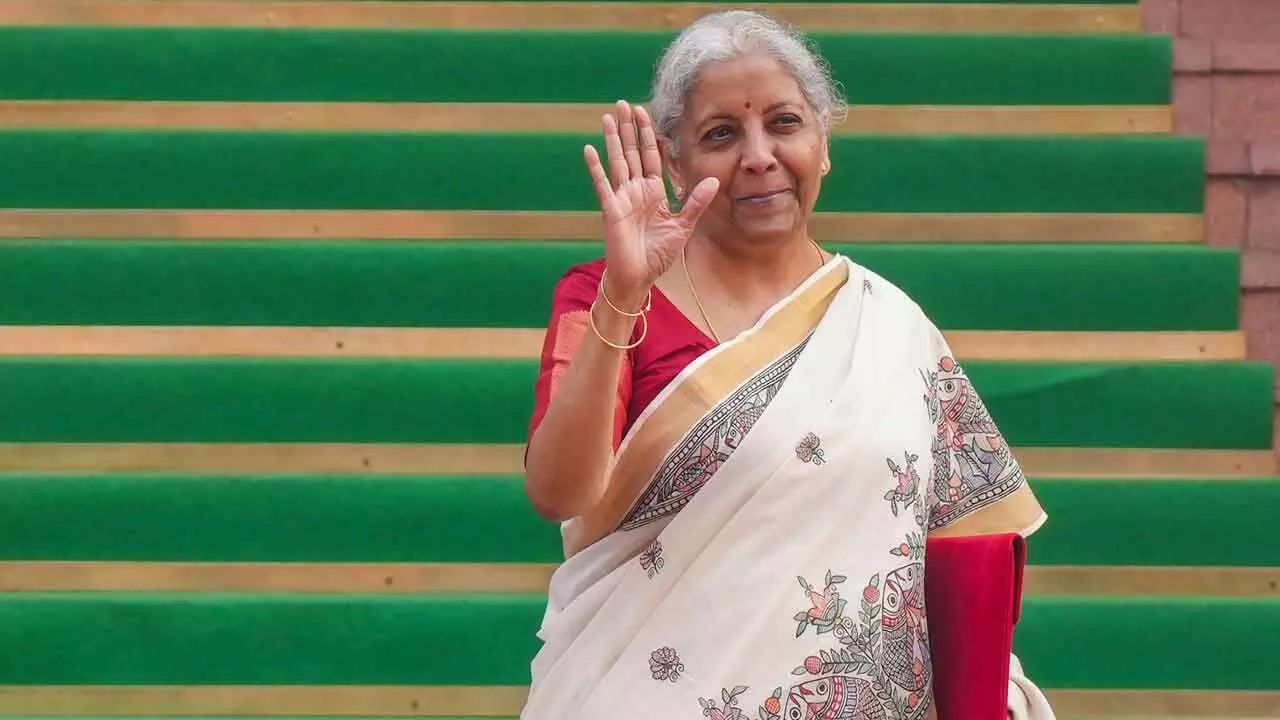Middle Class Modinomics
Union Budget 2025-26 identifies agri, MSMEs, investment and exports as growth engines
Middle Class Modinomics

Highlights
♦ Govt will table New I-T Bill
♦ Simplifying indirect taxes
♦ Removes 7 tariff rates
♦ Social Welfare Surcharge on 82 tariff lines
♦ Hikes FDI to 100% in insurance sector from 74%
♦ Total receipts other than borrowings at Rs34.96 lakh cr
♦ Total expenditure at Rs50.65 lakh cr
♦ Net tax receipts at Rs28.37 lakh cr
♦ Fiscal deficit at 4.4% of GDP
♦ Gross market borrowings at Rs14.82 lakh cr
♦ Capex expenditure at Rs11.21 lakh cr (3.1% of GDP)
♦ Investment, turnover limits for classification of all MSMEs to be enhanced to 2.5x and 2x, respectively
♦ PM Dhan-Dhaanya Krishi Yojana covers100 districts
♦ It’ll benefit 1.7-cr farmers
♦ 6-yr Mission for Aatmanirbharta in Pulses
♦ Makhana Board in Bihar to improve production, processing, value
♦ Urea Plant with capacity of 12.7 lakh MT in Assam
Union Budget 2025-26 will initiate reforms in 6 areas of taxation, urban development, mining, financial sector, power and regulatory framework — Nirmala Sitharaman, FM
New Delhi: Calling reforms the ‘fuel’ and paying attention to the plight of the middle class and concerns of entrepreneurs, Finance Minister Nirmala Sitharaman has offered a bold roadmap for the economy. Budget 2025-26 aims to stimulate the economy by offering significant income-tax relief to the middle class without bleeding the exchequer or losing focus on infrastructure building.
Total receipts (excluding borrowings) for the next fiscal are estimated to be Rs34.96 lakh crore, where total expenditure is expected to be Rs50.65 lakh crore. The net tax receipts will be Rs 28.37 lakh crore. The fiscal deficit is projected at 4.4 per cent of GDP, down from 4.8 per cent in 2024-25.
The capital expenditure will be Rs11.21 lakh crore (3.1% of GDP), 10 per cent more than the actual spend in the current fiscal.
In a big relief to the middle class, Sitharaman removed all personal income tax up to Rs12 lakh per year (Rs12.75 lakh for salaried individuals with standard deduction). The government will lose Rs1 lakh crore because of this decision, but expects a rise in consumption.
Senior citizens got another relief as the interest deduction limit doubled from Rs50,000 to Rs1 lakh.
The Finance Minister identified four growth engines of development: agriculture; micro, small & medium enterprises (MSMEs); investment; and exports. She proposed the Prime Minister Dhan-Dhaanya Krishi Yojana, a programme to cover 100 districts with low productivity to benefit 1.7 crore farmers. It employs a multi-sectoral approach focusing on skilling, investment, and technology to reduce under-employment.
Then there is the Mission for Aatmanirbharta in Pulses, a six-year initiative focusing on tur, urad, and masoor dals.
The National Mission on High-Yielding Seeds will work on research and commercial availability of over 100 seed varieties.
There will also be a focus on fisheries in Indian Exclusive Economic Zones (EEZs) and high seas, including Andaman & Nicobar and Lakshadweep.The Cotton Farming Mission, a five-year programme, will promote high-quality, extra-long-staple cotton.The loan limit has increased from Rs 3 lakh to Rs 5 lakh via Kisan Credit Card (KCC).She also announced a 12.7 lakh metric ton capacity urea plant to be set up in Namrup, Assam.
She also revised the MSME classification, increasing investment and turnover limits by 2.5 and 2 times, respectively. Micro-enterprises will be offered a million customized credit cards with Rs 5 lakh credit limit.
Sitharaman also announced a new fund of funds of Rs10,000 crore to support startups. She also announced special schemes for India’s footwear, leather, and toy industries and the National Manufacturing Mission.
The fourth engine, investment, aims to stimulate economic expansion. She promised 50,000 Atal Tinkering Labs in government schools, broadband connectivity to government secondary schools and PHCs, five national centers of excellence (CoE) for skilling, expansion of IITs and AI centres for education, and 10,000 additional medical college seats in the next year and 75,000 in five years.
Infrastructure-related ministries will come up with a three-year pipeline of projects in the public-private partnership (PPP) mode. The Finance Minister offered Rs1.5 lakh crore in interest-free loans for state capital expenditure which will be linked with reforms.
She also proposed an Urban Challenge Fund of Rs1 lakh crore to implement the proposals for ‘Cities as Growth Hubs’, ‘Creative Redevelopment of Cities’ and ‘Water and Sanitation.’
Another proposal is about top 50 tourist destination sites in the country which will be developed in partnership with States through a challenge mode.An Export Promotion Mission, with sectoral and ministerial targets, will be set up. It will be driven jointly by the Ministries of Commerce, MSME, and Finance. A national framework will be formulated as guidance to States for promoting global capability centres (GCCs) in emerging tier-2 cities, she said.
The Shipbuilding Financial Assistance Policy will be revamped.In the insurance sector, the FDI limit has been raised from 74 per cent to 100 per cent for companies investing their entire premium in India.
The Finance Minister has pledged to constitute a high-level committee for reviewing non-financial sector regulations.She laid a great deal of emphasis on winning the trust of wealth creators, decriminalization of regulatory provisions, etc.There have also been rationalizations in TDS and TCS. She announced several moves to enhance the ease of doing business (EoDB), including tax simplification, easier compliance, and fewer tariffs.

